

A platform chassis is a form of vehicle frame / automobile chassis, constructed as a flat plate or platform, sometimes integrating a backbone or frame-structure with a vehicle's floor-pan.


A platform chassis is a form of vehicle frame / automobile chassis, constructed as a flat plate or platform, sometimes integrating a backbone or frame-structure with a vehicle's floor-pan.
A platform chassis is a separate chassis for a car or small vehicle. It is distinguished from other forms of chassis by being arranged as largely a single flat steel sheet, usually with additional box section stiffeners. [1]
Platform chassis developed after the ladder chassis or cruciform chassis designs in the 1930s, once car bodies began to be pressed from large steel sheets, rather than the chassis assembled from rolled channel sections. As a semi-monocoque they are still a form of body-on-frame construction, rather than a monocoque or unibody where the bodyshell and chassis are integrated into one component. Although both body and platform chassis are each made from similar pressed steel panels welded together, they were often bolted as the final two units and so may still be separable after construction.
Achieving sufficient rigidity is difficult with a pure platform and so they are usually extended vertically with some form of box or tube section. This can be either a perimeter frame (e.g. Renault 4) or a central spine (e.g. VW Beetle). Longitudinal rigidity is more critical than transverse rigidity and so this stiffening is mostly as front to back girders, rather than crosswise. The diaphragm sheet is usually pressed into shallow stiffening ridges as well, but these are mostly to stop drumming noise and are too minor to provide major structural strength.
Platforms are usually the full width of the car, but shorter and only span the length between the wheels. Suspension attachments for the wheels and the weight of the engine and transmission are carried on additional subframes beyond this. These subframes may be formed of box section tubes welded on to the chassis, deep-drawn box sections formed from sheet, or as separate subframes that are bolted in place.
Platform chassis have been used for both rear-wheel drive (Beetle) and front-wheel drive (Renault) layouts. However they keep the engine at the driven end, with a transaxle, rather than using the propeller shaft of the Hotchkiss layout of front-engine, rear-drive that was universal with chassis designs beforehand. This avoided transmitting the propeller shaft torque through the platform. Where a propeller shaft has been used, these have been for rare examples with four-wheel drive.
Attaching the suspension to a platform chassis requires independent suspension and encourages the use of suspension features such as torsion bars or trailing arms. As the chassis is in a single plane, it would be difficult to use a solid axle, without raising the entire platform above the axle line. It is also difficult to arrange spring attachments for springs such as half-elliptic springs requiring distance fore and aft of the axle line, or for coil spring or strut suspensions needing an attachment point raised vertically above the platform. Instead, springs such as torsion bars are used. Whether these are transverse or longitudinal, they lie in the horizontal plane of the platform and so can be worked in to such a chassis. Other torsion-based systems, such as twist-beam rear suspension, may be used as well for front-wheel drive cars with light rears.
The Volkswagen Type 1 Beetle used a platform chassis, with independent torsion bar suspension at each end. The 'Volkswagen', 'Peoples' Car' or 'KdF-Wagen' project began in 1933 and by 1934 Porsche had sketched out a design for a rear-engined, platform chassis car with four seats and torsion bar suspension. [2] A central stiffening tube provided much of the strength of the chassis.
This basic design proceeded through the pre-war Porsche Type 60, and several wartime military vehicles, before finally the first post-war mass-production Volkswagen Beetles of 1945. [3]
In 1936, Porsche adapted the developing KdF-Wagen 'domestic' car as a sporting car suitable for the auto trials organised by the NSKK. These were slow-speed competitions across off-road terrain and obstacles, which developed both driving skill and vehicle agility, in ways which were expected to be useful for military motoring. This Porsche Type 62 was an open-topped, open-sided four seater, still with rounded bodywork. Although it performed well in military trials at Münsingen, its appearance was considered to be 'too civilian'. [4]
Porsche continued to develop the Type 62 with such features as a rear portal axle to give increased ground clearance and the ability to move with infantry at a walking pace. The rounded bodywork was also replaced with ribbed flat panels, with doors, [lower-roman 1] and by the end of 1939 this had been accepted as the military Type 82 Kübelwagen. [6] The Kübelwagen was highly effective, in large part due to the light weight achieved by use of its platform chassis. It weighed only 1,510 lb, the same design weight as the road car, and was 200-300 lb lighter than its rival vehicles from Opel, DKW and Adler. [7]
A four-wheel drive version was also developed, again using the same platform chassis and basic layout, but under the civilian enclosed bodywork. This became the Type 87 Kommandeurswagen (Porsche Type 287) and was intended for use by senior field commanders. The central tube of the chassis pan was enlarged to give space for a propeller shaft and a powered front axle provided, with similar driveshafts as the rear axle. [7]
The Beetle powertrain comprised a rear-mounted flat-four engine with a longitudinal transaxle ahead of it. The rear suspension was by swing axles. The first 1945 civilian Beetle used a platform chassis which stopped short of the rear wheels and which had a central stiffening tube. This tube extended rearwards as a Y-shaped fork, which passed each side of the transaxle and to the engine mounts. The rear swing axles were also held at their outboard ends by flat plate trailing arms, which were pivoted on the ends of a crosswise tube, containing the torsion bars. At this time the rear shock absorbers were only single-acting, lever-type. [8]
The front suspension was provided by pairs of short trailing arms, again with transverse torsion bars mounted in two separate tubes, mounted ahead of the flat platform. [9] These torsion bars were stacks of flat strips, and the number of leaves was changed to vary the suspension stiffness, over the production of the Beetle. [10]
An advantage for the production of the vehicle was that controls such as the driver's pedals and brake piping, the gear stick and the handbrake which required connections to the engine or drive train could be installed onto the platform before the body was added. Even, until 1952, [11] the engine choke control and its Bowden cable were mounted on the central tunnel. Unlike most contemporary chassis-on-frame designs though, the steering column was mounted on the bodyshell and was not connected to the steering box on the chassis platform until the two were joined.
In the 35 year production history of the Beetle, the basic platform chassis remained largely unchanged, except for one change to the front suspension of the 'Super Beetle'.
From 1970, the new 1302 'Super Beetle' adopted MacPherson strut front suspension. [12] This increased front luggage capacity by nearly 50%, also due to a slightly lengthened front bonnet, but the upper mounts of the struts now coupled suspension forces into the inner wing panels of bodyshell rather than the platform: the chassis was now no longer a pure platform. The 1303 'Super Beetle' continued in production until 1975, although the Economy Beetle continued in parallel with it, still using the trailing arms and platform chassis. [13]

The platform chassis, and the large number of available VW Beetles, encouraged the use of the Beetle platform as a donor car for building kit cars. The most iconic of these was the dune buggy: a stripped-down Beetle chassis, with the simplest fibreglass 'bathtub' body on top of this.
The first production dune buggy, the Meyers Manx, used a shortened VW platform as a basis. The front of the chassis was cut off and replaced by a taller structure of welded square steel tube. This made the front end vertically stiffer and the suspension was replaced by one based on Chevrolet parts, although still with double trailing arms. The Meyers Manx was widely copied and most of these copies retained the full VW platform and VW front suspension.

Platform chassis were not significantly more or less safe than contemporary ladder chassis, although much less safe in an impact than a modern design with a monocoque integrated into a passenger safety cell. They had a tendency in serious accidents for the complete bodyshell to separate from the chassis, as did the ladder chassis. However with the platform chassis, this formed the floor of the passenger area, rather than the body tub, and had the seats mounted to it. The passengers could thus stay with their seats on the chassis, while the bodyshell tried to pass through them.
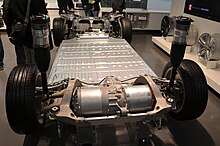
Modern developments of chassis materials, bodyshells materials and design, and also changes in drivetrain have given the platform chassis a resurgence. They are now in use for some electric and hybrid cars, such as the Tesla S.
An electric drivetrain (either hybrid or pure battery) does not require mechanical stiffness between an engine and final drive. The entire drivetrain can be mounted in a subframe at one, or increasingly both, ends.
Battery storage is required, and as the battery pack is heavy it is an advantage for stability to mount it in the largest flat layer, as low down as possible. The pack weight for a Tesla S is 1,200 pounds (540 kg) [14] As these are composed of 7,104 cells, packaged into 16 modules, [15] their overall shape is flexible and can be adjusted to best fit the vehicle. This makes the platform chassis a good way to carry it, with the batteries themselves either above or below the chassis platform, making them easier to access for exchange. [lower-roman 2]

A punt chassis is similar to the platform chassis, but in addition to the lower platform there are also deep raised sides. These give vertical stiffness, without requiring added stiffeners.
Punt chassis have often been used with armoured vehicles. The armoured outer bodyshell forms a robust monocoque which can serve double duty as the vehicle's chassis. Such armoured vehicles require all-wheel drive for off-road capacity with their weight, which many involve six or eight wheels, and so have often used a H-drive layout for the drivetrain. Rather than axles connected by a central propeller shaft, the two sides are linked fore-and-aft by driveshafts in the lower corners of the punt. This also allows greater useful space inside for crew or equipment. [16] [17]

The Volkswagen Beetle, officially the Volkswagen Type 1, is a small car produced by the German company Volkswagen from 1938 to 2003. One of the most iconic cars in automotive history, the Beetle is noted for its distinctive shape. Its production period of 65 years is the longest of any single generation of automobile, and its total production of over 21.5 million is the most of any car of a single platform.

The Volkswagen Type 82 Kübelwagen, or simply Kübel, contractions of the original German word Kübelsitzwagen, is a military light utility vehicle designed by Ferdinand Porsche and built by Volkswagen during World War II for use by the Nazi German military. Based heavily on the Volkswagen Beetle, it was prototyped and first deployed in Poland as the Type 62, but following improvements entered full-scale production as the Type 82. Several derivative models, such as the Kommandeurswagen, were also built in hundreds, or in dozens.

The Volkswagen Schwimmwagen is a light four-wheel drive amphibious car, used extensively by German ground forces during the Second World War. With over 15,000 units built, the Schwimmwagen is the most-produced amphibious car in history.

A torsion bar suspension, also known as a torsion spring suspension, is any vehicle suspension that uses a torsion bar as its main weight-bearing spring. One end of a long metal bar is attached firmly to the vehicle chassis; the opposite end terminates in a lever, the torsion key, mounted perpendicular to the bar, that is attached to a suspension arm, a spindle, or the axle. Vertical motion of the wheel causes the bar to twist around its axis and is resisted by the bar's torsion resistance. The effective spring rate of the bar is determined by its length, cross section, shape, material, and manufacturing process.

The Volkswagen Type 3 is a compact car manufactured and marketed by Volkswagen from 1961 to 1973. Introduced at the 1961 Frankfurt International Motor Show, the IAA, the Type 3 was marketed as the Volkswagen 1500 and later as the Volkswagen 1600, in two-door notchback, fastback, and station wagon body styles, the latter marketed as the 'Squareback' in the United States.

In automotive design, an RR, or rear-engine, rear-wheel-drive layout places both the engine and drive wheels at the rear of the vehicle. In contrast to the RMR layout, the center of mass of the engine is between the rear axle and the rear bumper. Although very common in transit buses and coaches due to the elimination of the drive shaft with low-floor buses, this layout has become increasingly rare in passenger cars.

In automotive design, an RMR, or rear mid-engine, rear-wheel-drive layout is one in which the rear wheels are driven by an engine placed with its center of gravity in front of the rear axle, and thus right behind the passenger compartment. Nowadays more frequently called 'RMR', to acknowledge that certain sporty or performance focused front-engined cars are also "mid-engined", by having the main engine mass behind the front axle, RMR layout cars were previously just called MR, or mid-engine, rear-wheel-drive layout), because the nuance between distinctly front-engined vs. front mid-engined cars often remained undiscussed.

A truggy is a type of high performance off-road racing vehicle that combines features from two older existing categories of off-road racing vehicles, trucks and buggies. The first truggies were built for racing in the SCORE and BITD off-road desert racing series, held in Mexico, California, Nevada and Arizona.

The Chapman strut is a design of independent rear suspension used for light cars, particularly sports and racing cars. It takes its name from, and is best known for its use by, Colin Chapman of Lotus.
A swing axle is a simple type of independent suspension, almost always for the rear axles, designed and patented by Edmund Rumpler in 1903. This was a revolutionary invention in automotive suspension, allowing driven (powered) wheels to follow uneven road surfaces independently, thus enabling the vehicle's wheels to maintain better road contact and holding; plus each wheel's reduced unsprung weight means their movements have less impact on the vehicle as a whole. The first automotive application was the Rumpler Tropfenwagen, later followed by the Mercedes 130H/150H/170H, the Standard Superior, the Volkswagen Beetle and its derivatives, the Chevrolet Corvair, and the roll-over prone M151 jeep amongst others.

The Volkswagen Type 181 is a two-wheel drive, four-door convertible, manufactured and marketed by Volkswagen from 1968 until 1983. Originally developed for the West German Army, the Type 181 also entered the civilian market as the Kurierwagen in West Germany, the Trekker in the United Kingdom, the Thing in the United States and Canada (1973–74), the Safari in Mexico and South America, and Pescaccia in Italy. Civilian sales ended after model year 1980.
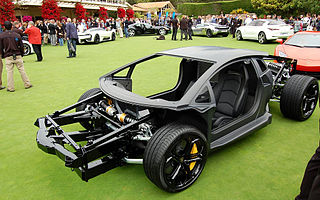
A subframe is a structural component of a vehicle, such as an automobile or an aircraft, that uses a discrete, separate structure within a larger body-on-frame or unibody to carry specific components like the powertrain, drivetrain, and suspension. The subframe is typically bolted or welded to the vehicle. When bolted, it often includes rubber bushings or springs to dampen vibrations.
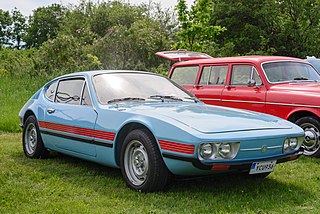
The Volkswagen SP2 is a sports car that was developed by Volkswagen do Brasil and built from July 1972 until December 1975. It is based on the chassis of the Brazilian market Volkswagen Type 3. "SP" is said to be an initialism of São Paulo, where the car was built, or of "sports prototype". In its issue of 20 June 1973, German technology magazine Hobby called the SP2 the "most beautiful Volkswagen in the world".

The Avenger GT was a kit car produced by Fiberfab. It was designed in California and manufactured in the United States and Canada for 12 years, from late 1966 until 1978.
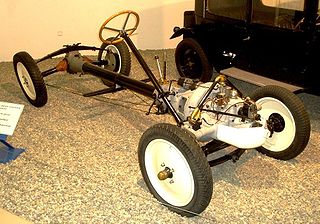
Backbone tube chassis is a type of automobile construction chassis that is similar to the body-on-frame design. Instead of a two-dimensional ladder-type structure, it consists of a strong tubular backbone that connects the front and rear suspension attachment areas. A body is then placed on this structure. It was first used in the English Rover 8hp of 1904 and then the French Simplicia automobile in 1909.

A vehicle frame, also historically known as its chassis, is the main supporting structure of a motor vehicle to which all other components are attached, comparable to the skeleton of an organism.

From 1931 to 1939, Daimler-Benz AG produced three cars with rear engine as well as a few prototypes. Production numbers remained low for each of these models, especially compared with the production of conventional front-engine Mercedes-Benz cars.
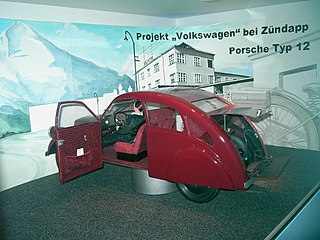
The Porsche Type 12 was a German project to develop an "Everyman's automobile" for Zündapp. Fritz Neumeyer, then owner of Zündapp, ordered Ferdinand Porsche to design and build the prototype in 1931. Eventually, two saloons, and one drophead coupé were built. All of those cars were lost during World War II, the last one in a bombing raid in Stuttgart in 1945. The Type 12 is considered an important early step in the development of the original Volkswagen. A replica of the Type 12 is on static display at the Museum Industrielkultur in Nürnberg.
The Volkswagen e-Beetle is a modified automobile first shown in October 2019 at IAA in Frankfurt. A donor Volkswagen Type 1303 Super Beetle convertible was updated by replacing the original petrol drivetrain with the electric motor, transmission, and battery used in the e-Up. Parts were taken from the regular Volkswagen production line, and installed by specialist partner eClassics in Renningen after consulting with Volkswagen Group Components.